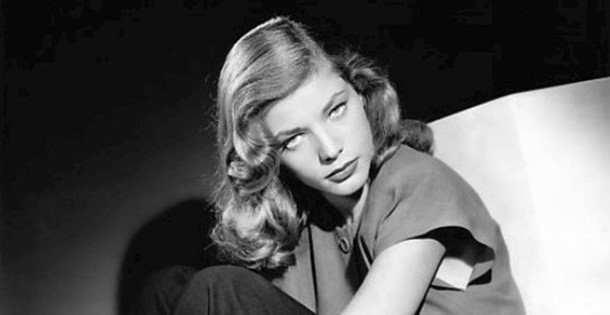Other features about the stars of Tinseltown can be found in the Post’s Special Collector’s Edition, The Golden Age of Hollywood. This edition can be ordered here.
This article was originally published in the Post on May 21, 1966.
At 8:30 P.m., on the drizzly New York evening of March 16, 1942, the opening-night curtain rose at the Longacre Theater on a play called JOHNNY 2 x 4, a noisy melodrama set in a 1926 Greenwich Village speakeasy, which involved a confusing number of gunshots, trumpet solos and dead bodies falling out of telephone booths. The following morning, the New York critics stomped all over JOHNNY 2 x 4, and it swiftly folded, remembered now only for the fact that listed fourth from the bottom in the play’s dense cast of 66 was one Betty Bacall, a 17-year-old hopeful who was making her Broadway debut as a walk-on extra.
“It was a rotten play,” admits Betty Bacall, who is, of course, now known professionally as Lauren Bacall—the ersatz label Lauren, a name she loathes, having been tagged on her by Warner Brothers some 15 months after the demise of JOHNNY 2 x 4. “But, rotten or not, I was terrifically excited to be in it. From as early as I can remember, I’ve been wildly stagestruck. As a kid I never even considered being in the movies, a second-rate medium, I thought, strictly for Priscilla Lane and Kay Francis. My dream was to star in a Broadway hit, to be another Katharine Cornell.”
From that bleak debut in 1942, the curtain now descends to denote the passage of 23 years, 8 months and 22 days, rising again to reveal the evening of December 8, 1965, when CACTUS FLOWER, a farce adapted from French by Abe Burrows, directed by Burrows and starring the aforementioned Miss Bacall in the role of a spinsterish dental nurse, opened in New York at the Royale Theater.
The following morning the New York critics fell all over themselves in praise of CACTUS FLOWER and Miss Bacall, after which the play rapidly ran up an advance ticket sale of $600,000. Thus, after only slightly less than a quarter of a century, Miss Bacall has at last had her dream come true—she is the season’s reigning Broadway female star in the town’s biggest new hit.
“It may have been a long time coming, but it feels good anyway,” Miss Bacall remarked cheerfully the other day, slouched in an easy chair in the high-ceilinged living room of her 12-room apartment in the Dakota, New York’s oldest and perhaps most elegant cooperative apartment house, at Central Park West and 72nd Street. She lives there now with her second husband, the actor Jason Robards Jr.; her two children by her first husband, the late Humphrey Bogart—a son, Stephen, 17, and a daughter, Leslie, 13; her child by Robards—a son, Sam, 4; a nurse; a cook; and a beagle named Benjamin.
In her familiar deep-throated voice, Miss Bacall explained that she was offered CACTUS FLOWER last summer while languishing in Hollywood, after having completed harper, a recent suspense film in which she is co-starred with Paul Newman.
On Life and Love
“The nicest things in life always seem just to happen by themselves, without one chasing after them,” Miss Bacall observed, settling again into the easy chair and lighting a filter-tipped cigarette. “It almost seems as though my entire life has been a trip to get to this point, to cacTus Flower. But, with one thing and another, I sure took the long way around, a long detour, and I traveled by roller coaster, a roller coaster on which the highs were as high as anyone could ever hope to go. And the lows! Oh, those lows were lower than anyone should ever have to go — ten degrees below hell.”
If Lauren Bacall’s journey to CACTUS FLOWER undeniably had its violent ups and downs, there is little argument that, after one or two early false starts, her acting career certainly started at the top of the roller coaster with TO HAVE AND HAVE NOT, the 1944 film in which she was co-starred with Bogart. And, curiously enough, her appearance in JOHNNY 2 x 4 led to the movie.
While none of the critics noticed Miss Bacall in her walk-on appearance, an eagle-eyed editor of HARPER’S BAZAAR had spotted her prowling gracefully into the speakeasy on the stage and had seen in her the makings of a high-fashion model. Before long, the young Betty Bacall was gazing languidly out of the pages of HARPER’S BAZAAR virtually every month, and in March 1943, she appeared on the magazine’s cover.
Then director Howard Hawks, in the midst of preparing a film for Warner Brothers of Ernest Hemingway’s TO HAVE AND HAVE NOT, saw one of Miss Bacall’s HARPER’S BAZAAR covers and brought her to Hollywood to play opposite Bogart.
Hawks began filming TO HAVE AND HAVE NOT in the late fall of 1943, and in the spring of 1944, the film was shown at a sneak preview in Huntington Beach, California. The audience went wild over newcomer Lauren Bacall and started her trajectory toward becoming the best-known young movie actress in the country.
Another result of the lm was the budding romantic relationship between Miss Bacall and Bogart. The two married on May 21, 1945, and Miss Bacall frankly remembers the first years of her marriage to Bogart as the happiest years of her life. “We were absolutely wild about each other,” she said recently. “When I was away from Bogie for even three or four hours, I couldn’t wait for the moment I saw him again, and he felt the same way about me. Luckily, we were almost always together, day and night, at home and at Warner Brothers, especially when we were working together in the same picture. In our eleven and a half years of marriage, until Bogie died in January 1957, I think we spent more time together than most couples do in 25 years of marriage.”
Though Miss Bacall’s private life was close to idyllic in the years immediately following her marriage, her lm career, with the exception of the movies she made with Bogart, went steadily downhill. In one picture after another, she was once again called upon to play essentially the same role she’d played in TO HAVE AND HAVE NOT— the slinky temptress with the sultry come-hither look.
The only one in Hollywood who suspected her natural talent for comedy was Nunnally Johnson, who in 1953 cast her in a comic role in HOW TO MARRY A MILLIONAIRE, in which many of her friends feel she gave the best performance of her career. Nevertheless, after HOW TO MARRY A MILLIONAIRE she was back again in come-hither roles.
By early 1956, the Bacall roller coaster, which had been pretty much riding the heights, despite her shaky career, for nearly a dozen years, began its descent to “ten degrees below hell,” when it was discovered that Bogart had cancer of the esophagus. For the next 10 months his health declined, until his death in the early hours of the morning of January 14, 1957.
The night before he died, Bogart knew that the end had arrived. Each evening before he went to sleep, he kissed his wife and said good night, but on that final evening, Bogart’s doctor later reported, he merely grasped Miss Bacall’s arm, gazed up at her and, in his imperishable Bogie voice, said only two words — “Goodbye, kid.”
At this point, her personal life had hit at a decidedly low point, and her career was pretty much at a low ebb too. It continued that way for the next several years. “By the summer of 1965, six weeks or so before CACTUS FLOWER came along, I was in the real doldrums. I was feeling about as low as I’d ever felt, but then, on July 14, I went a lot lower, all the way down to the bottom of the roller coaster. Adlai died.”
Miss Bacall was speaking of Adlai Stevenson, who was one of her great idols in life and one of her three or four closest friends. “I’d fallen in love with Adlai on television, when he’d made his acceptance speech at the convention,” Miss Bacall remembers, “but I fell even more in love with him when I met him. When Bogie died, Adlai was one of the people who helped get me through. I saw a great deal of him while he was ambassador to the U.N. He could always make me laugh and feel good again.”
Thankfully though, after that low point, the Bacall roller coaster began to rise again, a circumstance that has brought a new gleam into her eye. “I guess the essential fact about me right now is that I’m happy, really happy, for the first time in years,” she says. “For a long time, too, I’ve been living my life too much in retrospect, dwelling on the old days with Bogie, but I’ve stopped doing that. I live for now, and, with CACTUS FLOWER, now is a lot of fun. This is the year that I’m the star of a Broadway hit, and, dammit, I’m loving it while it lasts.”
Become a Saturday Evening Post member and enjoy unlimited access. Subscribe now



